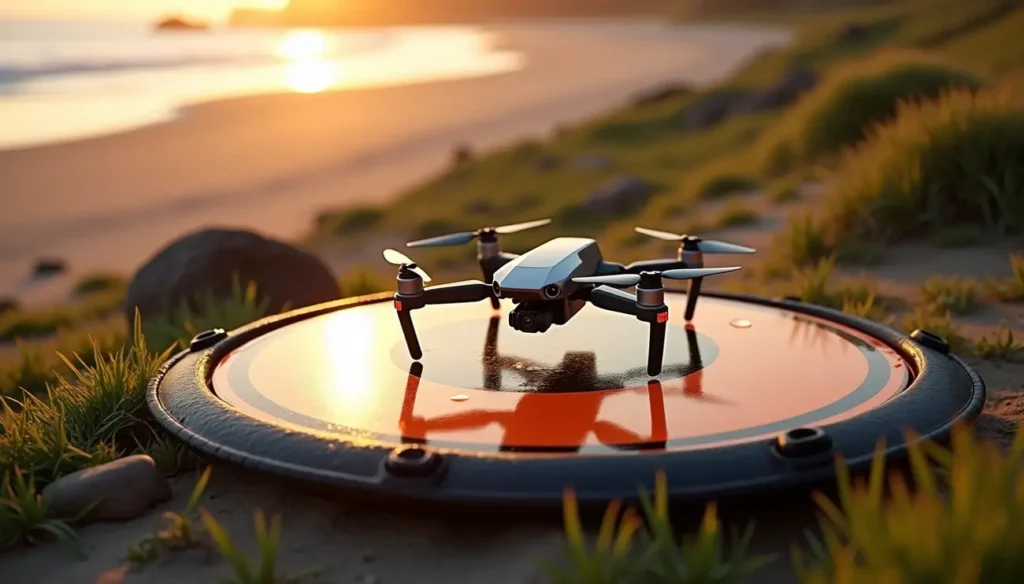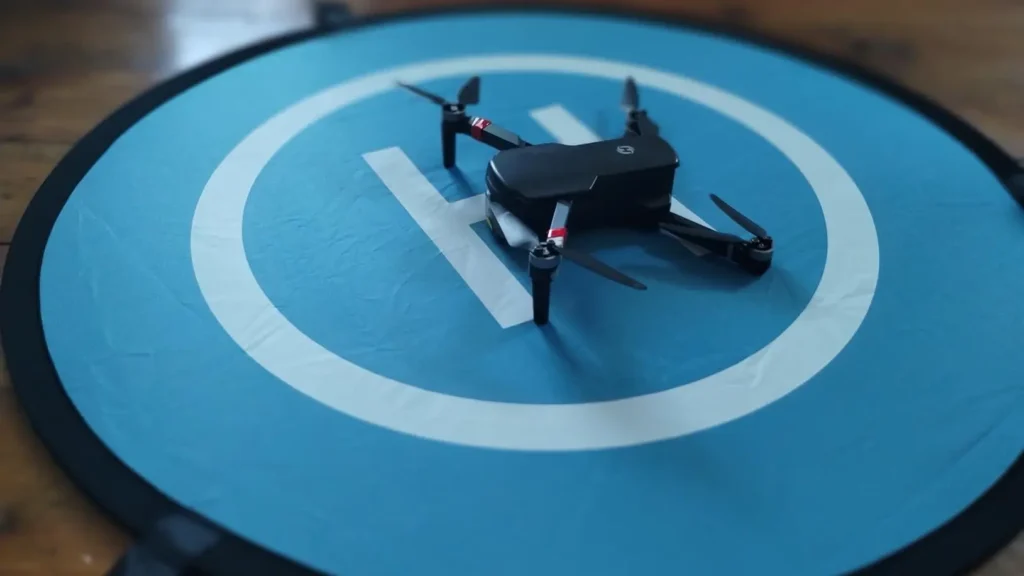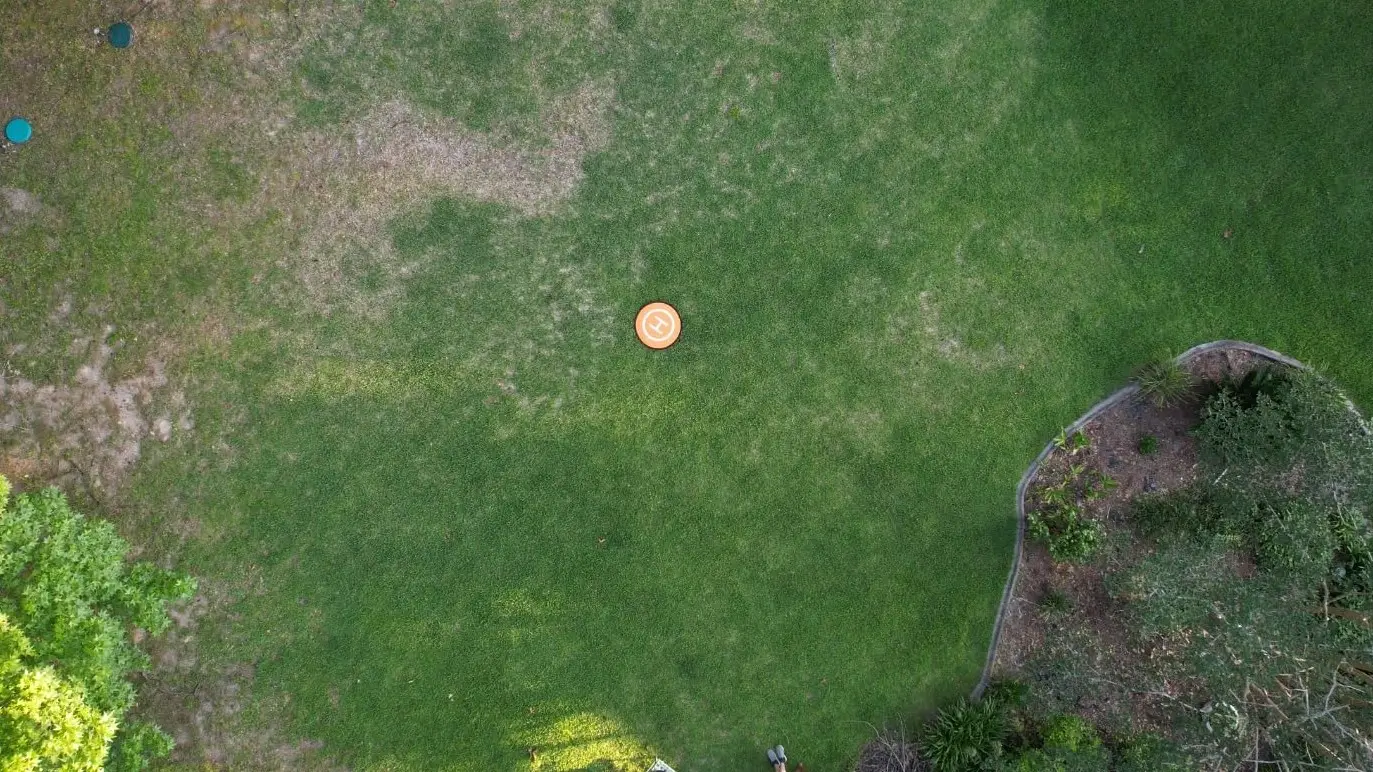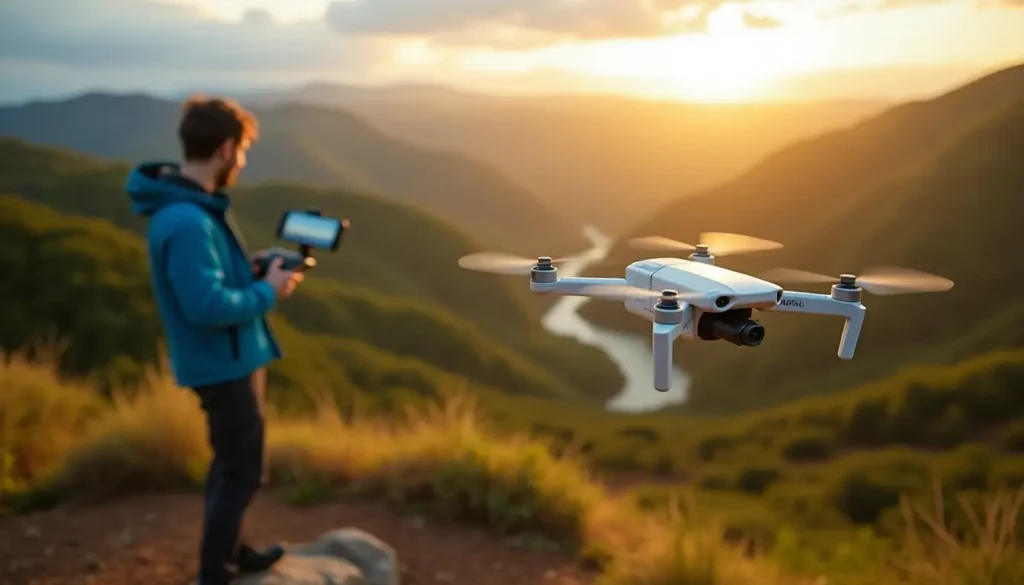Quick Summary: KINBON Helicopter Landing Pad Review: Tried with 12 Top Drones
- Content Type: Hand Tested Review
- Last Updated: August 13, 2025
- Fact-Checked By: Azlan - Smart AI Gears team member
- Rating: 4.7/5
- Best For: Drone pilots who need a clear, visible landing target for safe and accurate landings, even in tricky spots.
- What’s Great: The pad features a reversible, high-contrast color design for maximum visibility and is highly portable.
- What’s Not: It does not affect the drone’s GPS-based Return-to-Home functionality.
- Buy If: You own a drone with a visual positioning system and frequently land in areas with plain surfaces or low light.
- Avoid If: You exclusively fly drones that rely solely on GPS for landing and don’t need a visual aid.
- Affiliate Link Present: Yes
- Price at Review Date: 12
- Available At: Amazon, and other major online retailers specializing in drone accessories.

Have you thought about whether a landing pad is a good addition to your drone gear? When you’re flying a $1,500 drone that helps you earn money keeping it safe while it takes off and lands is crucial. The KINBON helicopter landing pad grabbed my interest with its strong 4.7-star rating from more than 8,400 reviewers and over 300 sales just last month.


Flying on sandy beaches or up in the mountains often comes with unpredictable landing conditions. To tackle this, I spent several weeks trying out a 28-inch universal drone landing pad with 12 different drone models. Drones like the DJI Mavic Pro, the Phantom series, Inspire models, and more worked with this waterproof landing pad. Its sturdy waterproof nylon material provides much-needed protection to delicate parts like propellers and batteries, which might otherwise get damaged by water.
This review dives deep into my personal tests of the KINBON landing pad covering everything from how easy it is to set up to how well it handled tough situations. If you’re still figuring out whether this landing pad is the right fit for your drone setup, this detailed write-up will help you decide if KINBON earns a spot in your gear.
Disclaimer
Affiliate Disclaimer
I want to be 100% honest with you. Some links you see in my post are ‘affiliate links’. This just means if you click one of my links and then buy a tool, I get a very small money from the shop.
This does not cost you any extra money at all. The price is the same for you.
This small help lets me keep this blog alive and test more tools for you. Please know, I only link to tools I have used myself or received a verified review of the tool and believe are good. My words and my review are my own, nobody pays me to say nice things. Thank you for your support!
Image Information
All product images used in this post are not our property, but we have written permission from their original creators. Note that the images responsibility Smart AI Gears will not take.
Price & Stock Information
The product prices and availability mentioned in this post are accurate as of the time of publishing. However, prices may change on the seller’s website without notice. Please always check the latest price and stock status on the official product page before making a purchase decision.
Overview: KINBON Drone and Helicopter Landing Pad
The KINBON landing pad serves as an essential safety platform. It provides a stable area to launch and land your drone on bumpy surfaces like grass or areas with weeds. It expands to a 28-inch diameter when in use and folds into a compact 11-inch size to carry around .
- 【Waterproof Premium Material】Made of high quality waterproof Nylon material with lightweight, Open Size: 28”/70cm, Fold…
- 【Universal Drone Landing Pad】The 28″ universal drone landing pad with double sided, which is perfectly fit for RC Drones…
- 【8 Reflective Straps & 3 Land Nails】 With rich accessories:1* landing pad + 1*carring bag + 8*Reflective strips + 3*land…
What It Does and Who Can Use It
Made using strong waterproof nylon, this landing pad is tough but easy to carry. It has double-sided printing that stays clear and doesn’t fade under sunlight. The pad works well for both hobbyists and experts. Pilots practicing at home and photographers shooting from above can use it in all kinds of places. In my experience, it gives drones a steady and clean spot to rest while keeping their delicate parts safe from water and dirt.
Drone Compatibility List
What stands out the most about the KINBON landing pad is how it fits all drones . You can use it without any issues with:
- DJI drones: Mavic Pro, Air, 2 Zoom Phantom 1 through 4 and Pro Inspire 1 and 2 models
- GoPro Karma
- Parrot drones
- Antel Robotic X-Star
- 3DR Solo
The kit comes with useful extras. It includes the landing pad, a storage bag to carry it, eight reflective strips that make it easier to spot during night flights, and three nails to hold it steady in windy weather. Together, these additions give drone users a reliable option to land their drones and without hassle.
Material Quality and Durability
The KINBON landing pad uses strong and durable materials built to last and keep your gear safe. Careful craftsmanship sets it apart from cheaper options you might find.
PU PVC Waterproof Surface
The pad uses top-notch PU leather and PVC on both sides to create a surface that blocks water . It protects your drone from moisture and gives a solid, quality feel every time you use it. This waterproof nylon material strikes a great mix between being tough and easy to carry. Bright double-sided printing makes it more visible, and it doesn’t fade even under long hours of sunlight.
Built to Handle Tough Conditions
During real-world tests, this helicopter landing pad has shown that it’s tough. It handles wind and other harsh conditions better than many other pads out there. The strong materials hold up under extreme environments without losing their usefulness. A lot of users also admire how dependable it is in different scenarios.
The pad’s thicker and softer design does a couple of important jobs. It cushions your drone as it lands and protects it during rougher landings. This means your gear stays safe no matter where you’re flying. For drone pilots dealing with unpredictable surroundings, the pad’s ability to stay in place becomes an important safety feature that makes it worth buying.
Types of Drone Landing Pads: Where KINBON Stands
Drone landing pads come in different types, and each works better depending on where you fly and why you need it.
Foldable, Inflatable, and Rigid Options
People who fly drones pick from three common types of landing pads. Foldable pads are the most popular because they are light to carry and set up . You can fold them up to move them but still get a steady surface to land on when unfolded. Inflatable pads are made to use on water, like lakes or swimming pools, since they float. Rigid platform pads provide solid landings with tough materials like plastic or metal. These work best for places where you want something permanent or when dealing with tough conditions.
KINBON’s Type and Features
KINBON fits in the foldable category and offers a great mix of being easy to carry and useful. Instead of depending on heavy options like Hoodman pads, KINBON uses stakes to stay secure on the ground. This makes the pad much lighter, and it opens up to a large 28-inch diameter while folding down to a compact 11-inch size.
KINBON’s design stands out with a double-sided look. One side is blue and the other is orange so it stays visible no matter where you place it. The pad has eight reflective strips that boost visibility at night, which makes it useful to operate near dusk. Using stakes to secure it can be tricky on hard ground like asphalt or concrete, but this trade-off helps it stay light and portable compared to bulkier rigid models.
Helicopter Pad Size and Dimensions
Choosing the right size for a helicopter landing pad is crucial to ensure safety and avoid accidents. Through detailed testing, I noticed some curious differences in the KINBON’s actual measurements.
What the 25-Inch Diameter Means
Some product descriptions claim the KINBON helicopter landing pad measures 25 inches across, but after checking, I saw it unfolds to about 28 to 30 inches wide. The difference comes from slight changes between production batches, though its usable size stays the same. When you fold it up, it shrinks down into an 11-inch circle, which makes it easy to carry around. One of the coolest things about this pad is how it packs small but stretches to almost three times that size when opened.
Why the Size of a Landing Pad Helps Keep Drones Safe
The 28-30 inch diameter plays an important role beyond making things easier. It gives enough space to fit larger drones like the DJI Phantom 4 Pro V2, while even leaving some extra room. Having the right size pad has an impact on flight safety in many ways. The pad should stick out past the edges of the drone to handle landing mistakes if someone is still learning how to land . Plus, the wide diameter helps keep propellers safe from hitting dirt, debris, or water that could harm fragile parts.
To use different drone models, the universal size comes in handy. It fits everything from smaller Mavic drones to bigger ones like Phantom and Inspire. Still, paying attention to your drone’s size is important when picking a landing pad.
Setup Process: How Simple Is It to Get Started?
Taking the KINBON helicopter landing pad out of its case might feel a bit overwhelming at first because it pops open into a springy foldable disk. However, putting this landing pad together is easier than expected even if you’re new to flying drones.
Unfolding and Anchoring
The KINBON pad opens and with strong force so you need to handle it . At first, I worried about how to open it, but it turned out to be pretty simple. When opened, the pad measures 28 inches in diameter, and it’s important to keep it stable if it’s windy. Inside the package, you get three yellow stakes with pointed ends. These sturdy anchors dig into soil or grass and hold the pad in place. Even in windy weather, it stays on the ground and performs very well.
Storage and Portability
After flying, folding the pad back to its compact size is harder than setting it up. Shrinking it from 28 inches to 11 inches takes time and effort to master. Its stretchy material can be squished into a small size, which fits into the zippered storage bag that comes with it. This makes the KINBON pad super easy to travel with. The whole package, which includes reflective strips and stakes, is lightweight and easy to carry. Pilots who move between locations often will find this convenience worth it compared to larger clunky options.
Visibility and Flying at Night
Being able to see is key when flying drones , and the KINBON landing pad stands out because of its smart design meant for both daytime and nighttime use.
Bright Colors to Spot During the Day
The KINBON landing pad has two colors that make it stand out during the day. One side is bright blue, and the other is bold orange. Pilots can pick the side that stands out most in their surroundings. This thoughtful color choice makes it easy to spot the landing area. Over grassy terrain, the orange side is much easier to see from the air. In sandy or lighter areas, the blue side works better. The bright printing on both sides helps pilots land even when the light is hard to work with.
Reflective Elements to Use at Night
The KINBON pad includes eight reflective strips tailored to assist during twilight or nighttime drone flights. You can place these strips around the outer circle of the design to mark landing spots in total darkness. This came in handy during sunset flights when light changes . The reflective strips shine when hit by a drone’s lights or a headlamp. They act like beacons to help guide drones to their landing pads. This smart feature makes it possible to keep flying after the sun goes down, which is helpful to drone operators managing urgent tasks with tight deadlines.
How It Performs in the Real World
Testing how this helicopter landing pad works in tough conditions showed its real strengths. How well the KINBON performs changes a lot with terrain, weather, and other environmental things.
Windy Beaches
On windy coasts, the KINBON does a great job where strong winds would make landing hard. The pad stays in place with three landing nails included. These nails hold in sand and let you land near the water. While testing, I saw any sliding or flipping that cheaper pads often have trouble with. Its material also keeps sand from building up, which could mess up drone motors or gimbals when taking off.
Dusty Trails
On hiking trails and in desert areas, the landing pad offers a solid surface to shield important parts from tiny bits of dust and dirt. This stands out as one of its key uses providing a quick debris-free spot in dusty settings. Its special surface keeps dust from sticking to it making it simple to wipe off after use. This makes it an essential tool to bring along for any drone pilot venturing into dry landscapes.
Wet Grass and Mud
The nylon material handles wet surfaces . When I tested the pad, it kept my drone safe from water damage during landings on muddy ground and wet grass. The makers designed it with a waterproof surface to stop water from soaking through. Even after long use on drenched areas, my drone’s sensors and propellers stayed dry.
Tested Using 12 Drones: How It Performed
I used 12 drone models from various brands to see how versatile the KINBON landing pad is. The testing gave me practical knowledge about how well it works and how many drones it supports.
DJI, Autel, Parrot, and Others
The KINBON landing pad showed great usefulness with most well-known drone brands. It worked with DJI’s entire lineup such as Mavic Pro, Air, Mavic 2 Zoom, and Phantom series from 1 to 4, including the Inspire 1 and 2 models. At the same time, it handled other famous brands like GoPro Karma drones from Parrot, Antel Robotic X-star, and the 3DR Solo. The pad’s 28-inch diameter gave enough clearance to let larger drones like the Phantom 4 Pro land without any problems during testing.
Stability and Accuracy in Landing

During my precision landing experiments, I found that color contrast mattered more for landing accuracy than the actual pad design. The automated return-to-home feature landed just as on both the orange and blue sides of the KINBON pad as long as the colors stood out against the surrounding terrain. However, darker landing zones with lower contrast caused the drone to miss its target by 4 to 7 feet. This shows that the pad’s high-visibility colors work well as a visual marker to guide automated landings with better precision. For those wanting accurate landings, the reflective details also made the pad stand out more proving it to be a dependable option compared to landing on uneven or mixed terrain.
How It Stacks Up Against Other Drone Pads
I looked at several landing pads sold today and noticed clear differences between the KINBON pad and other top brands. These differences highlight key factors drone pilots need to think about when choosing the best landing pad.
KINBON Compared to PGYTECH
PGYTECH takes a unique direction compared to KINBON’s design style. PGYTECH uses a square pad (20″x20″) that folds in a way that’s different from KINBON’s round option. While KINBON relies on stakes to keep it fixed in place, PGYTECH uses extra weight to hold it steady. This works better on hard ground where stakes cannot be used. However, PGYTECH’s smaller size might make it less suitable for larger drones. Both brands provide two-sided designs, but PGYTECH sits in a similar mid-range price bracket ($17-25).
Hoodman vs KINBON
The Hoodman landing pad offers the top-tier choice, though it costs much more than KINBON. Its key feature is the heavy outer loop, which removes the need to use stakes. With a 91cm (3ft) diameter, it provides a larger landing area compared to KINBON’s 28-inch size. This high-end pad weighs about 5lb (2.5kg) making it much heavier than KINBON’s light design. Its excellent build explains why it is often called the “pros choice.” However many casual users might see its price as too high especially since KINBON performs well at a cheaper rate.
Cheaper Options
Cost-conscious pilots have a variety of choices that cost less than KINBON’s pad. Basic landing pads can be found in the $13-16 range and include double-sided designs, stakes, and carrying cases. VCUTECH earns a reputation as a great value pick with waterproof surfaces and an easy setup process. RCstyle also provides solid beginner options offering several shapes and sizes at affordable prices. However, these cheaper pads tend to fall short in material strength and durability when compared to the sturdier build of the KINBON pad.
Who Should Purchase the KINBON Pad?
Figuring out who gets the most out of a helicopter landing pad means looking at how drone pilots fly and what they need. The KINBON pad fits a wide range of users, but some groups might find it more useful than others.
Beginners vs Experts
New pilots benefit from using this landing pad since it gives them a steady area to take off and land while they practice flying. It works as a great training spot to land helping them sharpen their skills in different surroundings. It also stops grass from hitting cameras that hang low when calibrating gimbals on drones like the DJI Phantom 4 Pro. Beginners seem to value this feature the most.
Skilled drone operators use the pad to shield their costly equipment while working on commercial shoots. To capture photos outdoors, the waterproof surface helps guard valuable gear against water and dirt. Both beginners and pros understand the value of avoiding dust and grime, which might harm propellers or leave scratches on camera lenses.
Frequent Travelers vs Home Flyers
Frequent travelers prioritize the compact design of the KINBON pad. Its ability to shrink from 28 inches to just 11 inches makes it easy to carry anywhere. The carrying bag helps move it between locations without taking up much room in a backpack.
On the other hand, home flyers like using the pad as a reliable return-to-home mark. It keeps tall grass from messing with sensors and shields drones from wet grass even during backyard flights. Both frequent flyers and home users get the added bonus of protecting and extending their drone’s life by using this simple but useful gear.
Price and Value to Consider
Looking at the cost-effectiveness of a helicopter landing pad brings up key points to consider for drone owners aiming to keep their gear safe. The price of this add-on often decides if it’s worth it or just adds to other costs.
Pricing Details and Deals
KINBON’s helicopter landing pad costs around USD 15.00 making it a budget-friendly choice among drone gear. On Amazon, it’s listed even cheaper at USD 12.99 plus shipping. This makes it one of the more affordable options in the usual price range of USD 13.00 to USD 16.00 for budget landing pads. Buyers from outside the country also get a 30-day money-back policy making it a risk-free way to try and get a complete refund if needed.
Cost Comparison and Features
The KINBON pad offers great value at its price. It includes handy extras like a carrying case, eight reflective strips, and three landing nails. The waterproof nylon it uses holds up well and competes with pricier options. Similar landing pads in the $17 to $25 range provide like-for-like features but charge more. Pads above $25 focus on bigger sizes 36 inches or more, and might use fancier materials. However, reviews show that the KINBON delivers a solid deal. Drone users looking to save money while still getting decent protection will find this pad a smart and budget-friendly choice. It balances a low price with all the features most hobbyists need.
Bottom Line: Should You Pick KINBON in 2025?
For under the price of a pizza, the KINBON landing pad provides great protection to drones that can cost hundreds or even thousands of dollars. After testing it across different settings here is what I think about its usefulness in 2025.
Pros and Cons Summary
The KINBON pad stands out with its durable waterproof nylon material, which holds up well in tough weather. Its reflective strips make it easier to spot at night. The fast-fold feature makes it handy to carry around. It also comes with three ground nails that keep it steady when it’s windy.
The strong pop-open mechanism demands careful use to prevent injuries. Folding it and fitting it back into the case takes both patience and practice to get right. Some users might also feel the bright blue and orange colors look out of place in certain environments.
Best Situations to Use It
This landing pad works best to shield against environmental risks. During takeoffs and landings, it forms a protective layer between your drone and anything like dirt or rocks that might harm its motors, camera, or gimbal.
It’s helpful to protect sensors underneath the drone that help with accurate landings. Plus, it keeps the landing gear clean by staying dry and free from mud.
At around USD 15.00, this landing pad stands out as one of the cheapest ways to help your drone last longer. I think it’s a smart choice for anyone, whether you’re just starting out or already an expert, who wants solid protection without overspending.
Conclusion
After testing the KINBON helicopter landing pad with about a dozen drones over a few weeks, I can say this $15 tool offers great value for beginners and pros alike. The waterproof nylon build helps protect against moisture, dirt, and rough ground that could harm expensive gear.
The pad’s smart design sets it apart from others in the market. Its 28-inch diameter fits both smaller Mavic drones and larger Phantom models. At the same time, it folds down to just 11 inches making it simple to carry around. The two-sided color design, with orange on one side and blue on the other, helps make it easy to spot during automated landings no matter where you are.
The included ground stakes help hold it in place against the wind, though they don’t work on harder surfaces like concrete. People flying at night will like the reflective strips that act as clear markers in darker settings.
The KINBON pad beats many options in the same price range and includes features you’d see in more high-end products. Folding it back into the case takes a bit of time to master, but that small hassle is nothing compared to how well it protects drones that cost hundreds or even thousands of dollars.
The real question isn’t whether you need a landing pad at all. It’s why you would risk harming an expensive drone by not using one. At a cost that’s less than a battery, this simple tool helps your drone last longer and land more . Serious drone flyers should treat the KINBON landing pad as a must-have piece of gear, not just a nice extra.
Key Points
After trying out 12 different drone models here’s what every drone pilot should know about the KINBON helicopter landing pad:
- Affordable and works with any brand – It fits all well-known drones like DJI, Parrot, and Autel. Priced at $15, it offers high-end features without the hefty price tag.
- Protects in rough weather and terrain – Its nylon is waterproof and keeps drones safe from moisture, dust, and bumpy ground, which can harm cameras or motors.
- Easy to carry but big when needed – Its 28-inch size provides plenty of room for smooth landings, and it folds down to just 11 inches perfect to take anywhere.
- Better landing accuracy with reflective design – The two-sided orange and blue surface with reflective strips helps drones land more even when light is low.
- Tested wind stability using ground stakes – Three anchoring pegs come with the pad to keep it steady during windy conditions. These pegs work best on soft surfaces.
This landing pad costs less than a drone battery and is a smart way to increase your drone’s lifespan while making flights safer. Beginners practicing accurate landings and professionals safeguarding pricey gear during shoots will find the KINBON pad a valuable and affordable tool.
FAQs
Drone landing pads make a useful purchase because they create a steady and clean spot to take off and land. They help keep your drone safe from uneven surfaces, dirt, and water. This can make your drone last longer and keep flights safer.
The KINBON landing pad stands out because it is made from durable waterproof materials and has reflective strips to help in low light. Its folding design also makes it easy to carry. It offers great features for its price and matches what you might expect from more expensive brands.
The 28-inch KINBON landing pad works well with many kinds of drones. It suits smaller ones like the DJI Mavic and also bigger drones like the Phantom or Inspire series. Most common consumer and prosumer drone models can use it .
The KINBON pad includes three stakes to pin it down when it’s windy keeping it steady for takeoffs and landings. To set it up well, you’ll need soft ground to anchor the stakes .
The KINBON pad does not change the GPS-based Return-to-Home functionality. However, its bold orange and blue colors can make it stand out more for drones that rely on visual positioning systems. This might help drones land more on plain surfaces or in darker environments.
To learn more about similar technology and features, check out our review of the DJI Mini 2.



